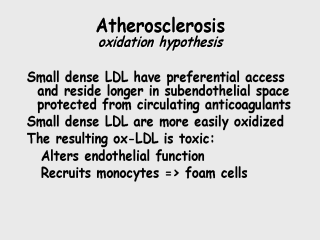 |
One of the concepts
that has guided thinking about atherosclerosis in its pathophysiology is what’s called
the oxidation hypothesis. This proposes that those small dense LDL that I alluded to that
increases preeclampsia and in atheroscleoris, that these had preferential access to
subendothelial space and in that setting are protected from circulating antioxidants, not
anticoagulants. So these LDL get underneath the endothelia and in that setting they are
exposed to certain anticoagulants and in addition, they are inherently more easily
oxidized. Those small dense LDL result in the formation of oxide LDL, which alters
endothelial function, recruits monocytes, and eventually foam cells, and so on. Go to Part III of this lecture
 |
Go to Comment Form |
|
